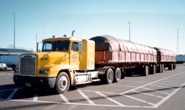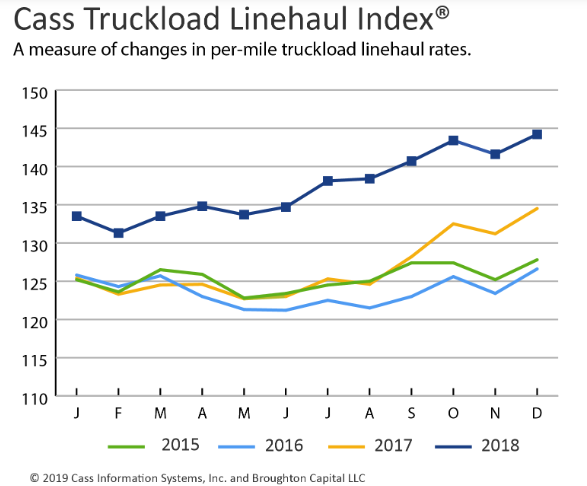Shipping and Logistics

Truckload Capacity Eases After Holidays
Written by Sandy Williams
January 19, 2019
Truckload capacity eased following the holidays, reducing average rates for dry van, reefers and flatbed trucks. DAT Trendlines reports the national load-to-truck ratio fell from 33.7 to 25.1 loads per truck in the week Jan. 6 through Jan. 12.
Flatbed rates came down four cents to a national average rate of $2.42 per mile during the Jan. 6-12 period mostly due to lower fuel surcharges. Diesel fuel prices dipped 1.3 percent to $3.01 per gallon.
Flatbed rates held relatively steady at an average of $2.42 per mile November through December, but were 10 cents higher than average rate for December 2017.
The Cass Truckload Linehaul, a measure of changes in per-mile truckload linehaul rates, rose 7.2 percent year-over-year in December. The Index rose sharply last year making 2018 “the highest year of realized pricing for truckloads since deregulation in 1980, setting a new all-time high of 144.2,” reported Cass Information Systems.
“We expect continued nominal price increases in the coming months, but slightly lower percentage increases as comparisons grow increasingly tough,” stated Donald Broughton, analyst and commentator for the Cass indexes. “Our realized pricing forecast for 2019 is now 2 percent to 5 percent.”
Broughton said in the December Cass Freight Index Report that the transportation sector indicates the economy is continuing to expand just “perhaps not at the scorching pace attained earlier this year, but still at an above-average pace.”

Sandy Williams
Read more from Sandy WilliamsLatest in Shipping and Logistics

US Great Lakes iron ore cargoes down notably through May
The Lake Carriers' Association reported a considerable decline in monthly iron ore shipments from US ports on the Great Lakes.

Wittbecker: West Coast port congestion
What's going on in West Coast ports?

Wittbecker: Mexico invests in port capacity despite US tariff troubles
The Mexican government aims to transform Manzanillo into the largest seaport in Latin America, capable of processing some 10 million TEU (20-foot equivalent units) per year by 2030. It is already Mexico's largest port and the third largest in Latin America, handling nearly 4 million 20-foot containers in 2024.

Wittbecker on Aluminum: When do the tariffs reach Main Street?
Containers sailing from China in April are down 15%-20% and Hapag Lloyd says their future bookings transpacific are down 30%.

Wittbecker on Aluminum: US-China trade war clobbers cross-Pacific trade
Container shipping lines have sharply increased blank sailings on Transpacific routes in response to escalating trade tensions between the US and China.

